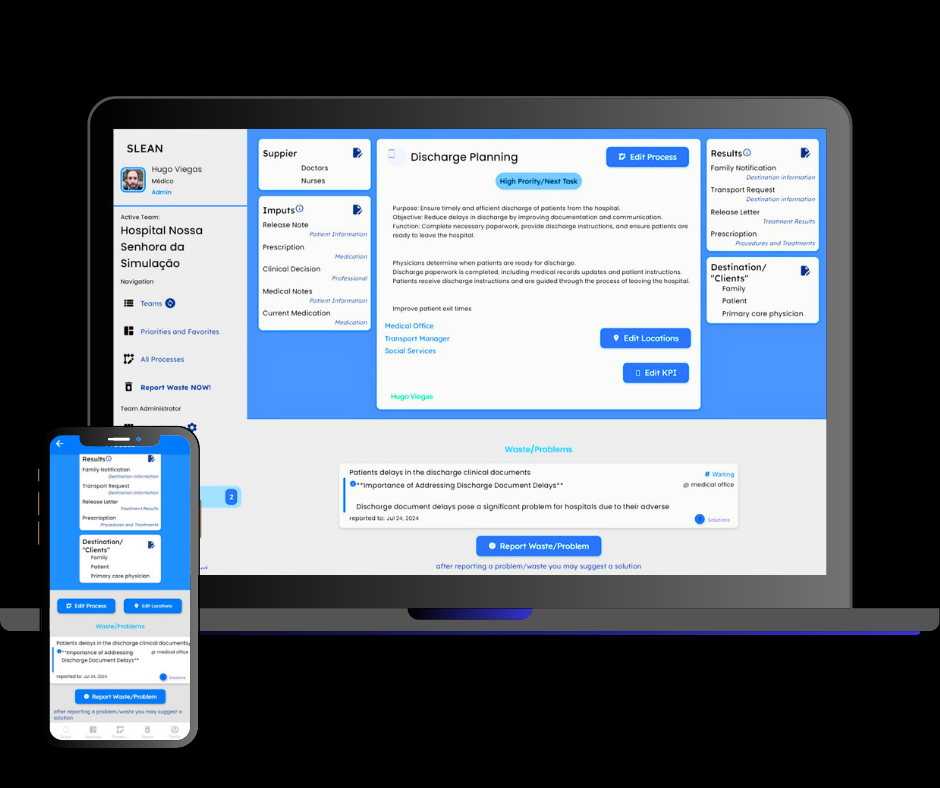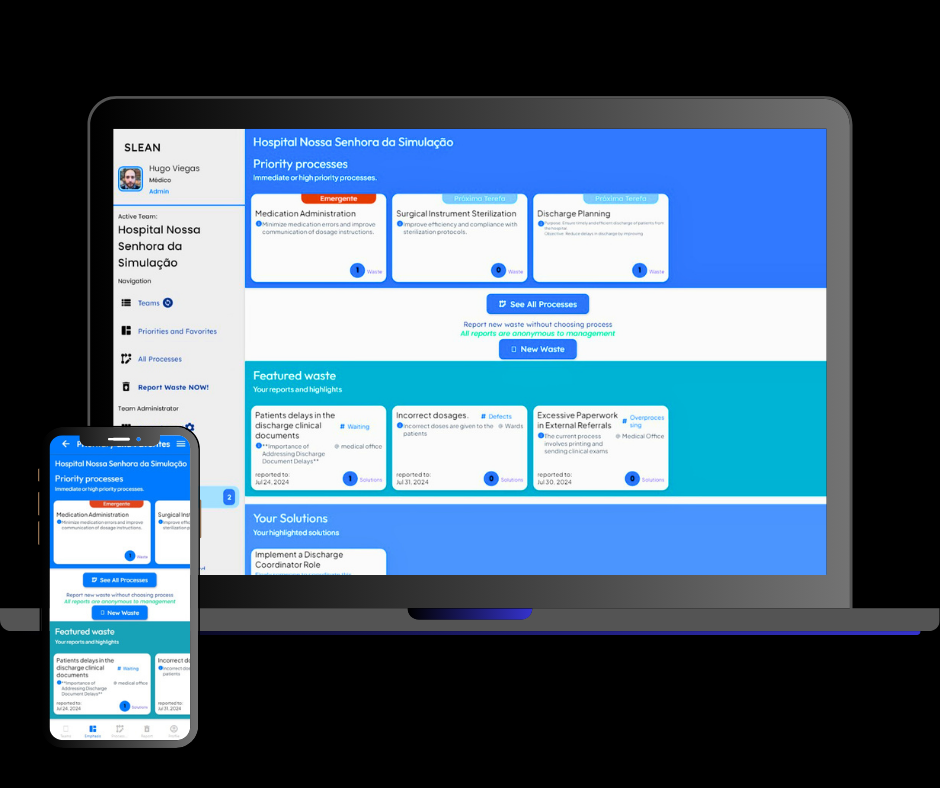# Lean Six Sigma Healthcare Tool
Revolutionize Efficiency with Lean Six Sigma Healthcare
Welcome to SLean, an app to transform your healthcare organization mindset making all your workforce dedicated to improvement. Easly train your workers and harness the power of Lean and Six Sigma methodologies to optimize workflows, eliminate waste, and drive continuous improvement.
How many project have Failed before?
Are you a Healthcare Administrator, Hospital Manager, Chief of Staff, Senior Nurse, or Medical Director?
-
Plenty of great ideas but struggling to challenge the status quo? -
Healthcare workers always complain about the same issues? -
Tired of desorganized mettings? -
Great projects left for dead? -
Why do we keep doing ineffective things we don’t want to do?
Amazing Features
All your workers are engaged in improving your workflows!
Boost the
Continous social Gemba Walks
Every healthcare worker will be engaged in Collaborative Waste Identification, problem definition and solution discusions.
Easy to Use
The app is designed for guided and easy to use basic Lean and Six sigma features making every healthcare worker a green belt.
Standardize (Seiketsu) and Sustain (Shitsuke)
Training Module: easy to follow videos for training your workforce.
Social Engagement feature to help sustain the improvement mentality
How SLean Healthcare Works?
Each successful referral is scored, creating an engaging and rewarding experience.
Leader defines the processes
The process is defined using a SIPOC diagram (Six Sigma). The leader establishes the priority of each process to guide workers and manage expectations.
Collaborative Waste Reduction
Continuous Gemba Walk, engage your entire team in identifying and resolving issues. Every team member can report wastes, apply the 5 Whys from their perspective, and vote on the impact of the waste on their work.
Gather ideas from the real workers
Digital Suggestion Box: Collect ideas for improvement from all staff levels. Utilize voting, discussion forums to improve the idea.
Our Special Features
Driving Continuous Improvement with the Best Lean Six Sigma Healthcare Process Improvement App
SIPOC and Value Stream Mapping
Process Definition
Value Stream Mapping (under development)
Gemba Walk and 5 Whys
Problem identification
5 Whys Tools (under development)
AI helper
Advanced AI generated waste indentification and KPI sugestions
Night Mode
For night very dark shifts ^0^ ^0^
Solution Design
Digital Suggestion Box: Gather ideas for improvement from all staff levels. Use voting and discussion forums to develop and select the best solutions. Guide users through the 5S process: Sort, Set in Order, Shine, Standardize, and Sustain.
AI generated plans
Accelerate complex tasks with AI-generated plans, already organized in SCRUMs and by complexity
Implementation
Kanban and SCRUM organization for Agile implementation of solutions
Backlog management for improvement ideas
Analysis
Easy-to-use KPI register and timers for patient tracking
Data integrated into the Value Stream Mapping
APIs under development to connect with existing healthcare IT systems
Teaching
AI chatbot AI chatbot for Lean and Six Sigma support
Short educational videos and built-in Lean and Six Sigma training modules
Best practices library
AI-generated success stories for sharing
Pricing
For Lean or Six Sigma consultancy agency or multiple subscriptions for the same company, Contact us!
Aspiring
21€
/month
-
1.4€/user/month -
15 users -
1 Administrator -
3000 AI credits - Unlimited problems and solutions
- SIPOC and Process priorities
-
Basic 5 Whys sugestions - Basic reports with watermark
Excitment
55€
/month
-
1.22€/user/month -
45 users -
3 Admin Users -
9000 AI credits - Unlimited problems and solutions
- SIPOC and Process priorities
-
Basic 5 Whys sugestions - AI generated Reports (under development)
Dreaming
89€
/month
-
0.89€/user/month -
100 users -
6 Admin Users -
20.000 AI credits - Unlimited problems and solutions
- SIPOC and Process priorities
-
Advanced 5 Whys sugestions (under development) - AI generated Reports (under development)
-
Value Stream Mapping (under development) -
Hands On Patient Tracking (under development)
Revolution
233€
/month
-
Unlimited users -
6 Admin Users -
Unlimited AI credits - Unlimited problems and solutions
- SIPOC and Process priorities
-
Advanced 5 Whys sugestions (under development) - AI generated Reports (under development)
-
Value Stream Mapping (under development) -
Hands On Patient Tracking (under development)
Lovely Testimonials
Testimonials from the early stage surveys for idea validation. Soon to be replaced by the actual users!
SLean Healthcare will transform our services. The app offers a collaborative platform that fosters teamwork and continuous improvement through Lean and Six Sigma. The efficiency gains are evident, making it an indispensable tool for any healthcare institution.
Healthcare Administrator
SLean Healthcare is essential for advancing quality care in our hospital. The Lean and Six Sigma methodologies provided by the app have helped us streamline operations, reduce waste, and improve patient outcomes. The collaborative approach to problem-solving has been invaluable.
Senior Nurse
Nurse
We have tried integration of Six Sigma into our processes which has significantly reduced variation and defects but it was very hard to mantain the changes. SLean motivates our staff, driving both professional development and institutional growth.
Hospital Manager
SLean Healthcare is a game-changer for healthcare institutions. The app simplifies task management, encourages a proactive approach to identifying and solving inefficiencies, and supports the Six Sigma approach to process control. The incentives for contribution significantly value the work of our professionals, providing a stimulating environment for both professional and academic development.
Medical Director
Doctor
0
+
Teams
0
+
Processes
0
+
Wastes reported
0
+
Solutions upvotes
Frequently Asked Questions
Feel free to contact us if you have more questions.

Who subscribes to SLean?
SLean should be subscribed by team leaders of any department or team seeking to improve their processes.
Who can use the SLean app?
SLean Healthcare is designed for a wide range of healthcare professionals and institutions focused on improving efficiency, quality of care, and operational processes. Here’s who can benefit:
- Healthcare Administrators: Oversee hospital or clinic operations, using SLean to optimize workflows and resource management.
- Quality Improvement Teams: Enhance the quality and safety of healthcare services through tools like root cause analysis and DMAIC.
- Doctors and Physicians: Streamline patient care processes, reducing administrative burdens and improving care quality.
- Nurses and Clinical Staff: Organize daily responsibilities more effectively and participate in continuous improvement initiatives.
- Hospital Managers: Monitor and improve departmental efficiency, motivating staff with gamification to participate in improvement projects.
- Lean Six Sigma Practitioners: Utilize tools like DMAIC and control charts to implement and sustain Lean Six Sigma methodologies.
- Healthcare Educators and Trainers: Use SLean as a teaching tool for practical applications of Lean and Six Sigma in healthcare.
- Research and Development Teams: Streamline research processes, improve data collection, and implement findings more effectively.
- Public Health Institutions: Improve the efficiency of public health programs, ensuring optimal resource allocation and service delivery.
- Clinical Operations Teams: Optimize clinical operations, reducing delays and improving the efficiency of clinical trials and patient care processes.
How is my company data used?
The SLean app uses advanced encryption and secure protocols to protect all user and company data. We comply with all relevant data protection regulations, including GDPR and HIPAA, to ensure patient confidentiality and data security. We won’t use or give your data to third parties. Please check out privacy documents for more information.
Can SLean Healthcare be used in any healthcare institution?
Yes, SLean Healthcare is designed to be flexible and adaptable, making it suitable for use in various healthcare settings, including hospitals, clinics, and other medical facilities. It can be customized to meet the specific needs of different institutions.
How does SLean manager worker expectations?
SLean Healthcare effectively manages worker expectations through a priority system and feedback mechanisms:
- Priority System: Directors and managers can inform the team about the processes being worked on, ensuring transparency and managing expectations.
- Worker Feedback: Workers can rate inefficiencies based on their perspective, allowing management to prioritize issues that matter most to the team.
- Continuous Improvement: By involving workers in problem-solving and offering recognition through gamification, SLean fosters a culture of engagement and timely implementation of solutions.
How does SLean Healthcare support continuous improvement?
SLean Healthcare supports continuous improvement by providing tools that help teams identify problems, implement solutions, and monitor the effectiveness of these solutions over time. The app’s integration of Lean and Six Sigma methodologies ensures that improvements are data-driven and sustainable.
What are the future features planned for SLean Healthcare?
Future Features Planned for SLean Healthcare
- Advanced 5 Whys Tools: Enhanced root cause analysis with advanced 5 Whys tools to dig deeper into problems and find effective solutions.
- Value Stream Mapping: A tool to visualize and analyze the entire patient journey, helping identify and eliminate waste in the process.
- Kaizen Events: Facilitate rapid improvement events focused on specific areas within healthcare services, driving quick and impactful changes.
- Hands-On Patient Tracking with Time Trackers and API Integrations: Implement time trackers and integrate with existing systems via APIs for real-time patient tracking, ensuring efficient and accurate management.
- AI-Generated Reports: Automatically create detailed reports summarizing findings and improvements, making it easier for superiors to monitor progress and make informed decisions.
Download Our App!
Try the app now today with our simulaiton institution.
Have free access to the comon country and world-regional portfolio.
Not ready yet?
Contact us!
Book a Meeting!
From our blog
Latest News
Financing Publication Journals: Unlocking New Revenue Models
Financing Publication Journals: Unlocking New Revenue Models Table of Contents Introduction Why Monetization Matters How to Finance Publication Journals Negative Effects of Entry Prices Ethical Problems Related to Paying Reviewers Important Open Source Journals Eligible4’s Impact on Financing Profitability and Its Impact on Science Can a Community Decentralized Autonomous Organization (DAO) Research Journal Work? Conclusion Introduction Are you a researcher struggling with the high costs of publishing your work? Or perhaps you’re an editor grappling with the financial sustainability of your journal? The skyrocketing prices of publication and the increasing costs associated with high-quality research have become significant hurdles in […]
Meta-Analysis in Clinical Research: A Guide on how to Perform One Correctly
Meta-Analysis in Clinical Research: How to Perform One Correctly Table of Contents Introduction What is Meta-Analysis in Clinical Research? Why is Meta-Analysis Important in Clinical Research? Steps to Conduct a Meta-Analysis Define the Research Question Conduct a Systematic Literature Review Select Studies for Inclusion Extract Data Assess the Quality of Studies Perform Statistical Analysis Interpret the Results Tools and Resources for Meta-Analysis Common Pitfalls and How to Avoid Them Conclusion Introduction Are you a beginner investigator struggling with conducting meta-analysis in clinical research? You’re not alone. Many researchers face challenges in accurately synthesizing data from various studies. Meta-analysis is a […]
Best Practices for Writing Abstracts in Scientific Papers: A Complete Guide
Best Practices for Writing Abstracts in Scientific Papers: A Complete Guide Mastering Best Practices for Writing Abstracts in Scientific Papers Table of Contents Introduction Why Your Abstract Matters Key Components of a Well-Written Abstract Best Practices for Writing Abstracts Common Mistakes to Avoid How Eligible4 Can Help Conclusion Introduction Writing abstracts for scientific papers can be a daunting task. Imagine spending months, if not years, on groundbreaking research only to find out that your paper is getting overlooked because of a poorly written abstract. The abstract is often the first thing people read and can be the deciding factor on […]








